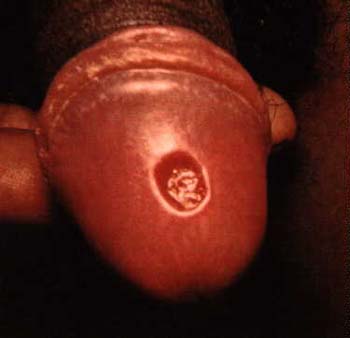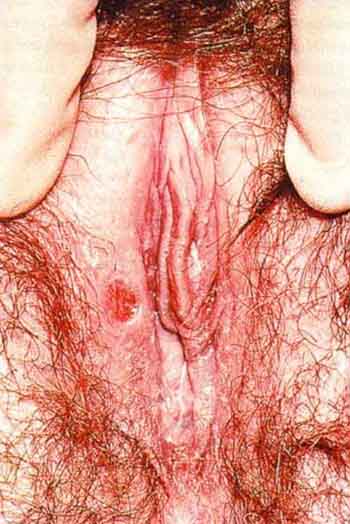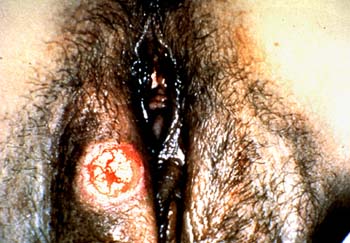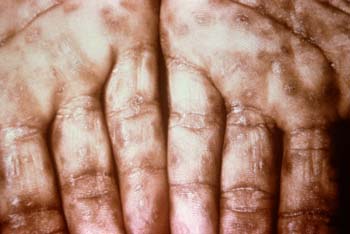
Primary syphilis in a male on penis

Primary syphilis ulcer in a male on penis

Primary syphilis in a female on vulva

Primary syphilis in a female on vulva

Secondary syphilis lesions on palms, Courtesy wiki
Syphilis
Syphilis is a sexually transmitted disease caused by bacteria. it infects the genital area, lips, mouth, or anus of both men and women. Syphilis is transmitted from sexual intercourse with infected person. it can also be transmitted to babies from infected mother during childbirth.
Cause
Syphilis is caused by a bacterium called Treponema pallidum.
Transmission
The most common way to get syphilis is by having sexual contact with an infected person. infected person can pass the bacteria from infected skin or mucous membranes (linings), usually from genital area, lips, mouth, or anus, to the mucous membranes or skin of healthy sexual partner. Syphilis can be passed from mother to infant during pregnancy, causing a disease called congenital syphilis.
Symptoms
Primary Syphilis
Earliest symptom of primary syphilis is often a small, round, firm ulcer called a chancre ("shanker") at the place where the bacteria gained access inside the body. This place is usually one of the mucous membrane covered part of the body like the penis, vulva, or vagina, but chancres also can develop on the cervix, tongue, lips, or other parts of the body. Nearby lymph glands are often swollen. Lymph nodes, are small nodules present in every person at different part of the body. Normally they can not be felt by fingers but in very thin person, it can be normal to feel them in the axilla or groin. The chancre usually appears about 3 weeks after a person is infected with the bacteria, but it can occur from several weeks to months after exposure.
Because a chancre is usually painless and can appear inside the body, a person might not notice it. The chancre disappears in about 3 to 6 weeks whether or not a person are treated. Therefore, a person can have primary syphilis without symptoms or with only brief symptoms that could be overlooked. if primary syphilis is not treated, however, the infection moves to the secondary stage.
Secondary syphilis
Most people with secondary syphilis have a non-itchy skin rash. Although the rash is usually on the palms of body hands and soles of body feet, it may cover the whole body or appear only in a few areas. The rash appears 2 to 10 weeks after the chancre, generally when the chancre is healing or already healed. Other common symptoms include Sore throat, Tiredness, Headache, Swollen lymph glands, and hair loss.
Less frequent symptoms include fever, aches, weight loss, hair loss, aching joints, or sores in the mouth or genital area. Symptoms may be mild. The sores of secondary syphilis contain many bacteria, and anyone who has contact with these sores can get syphilis. As with primary syphilis, secondary syphilis will seem to disappear even without treatment, but the bacteria are still present in the body. There may be recurrences of secondary syphilis, but without treatment, the infection will move to the next stages.
Latent syphilis
The latent (hidden) stage of syphilis begins when symptoms of secondary syphilis are over. in early latent syphilis, a person might notice that signs and symptoms disappear, but the infection remains in body body. When a person are in this stage, a person can still infect a sexual partner. in late latent syphilis, the infection is quiet and the risk of infecting a sexual partner is low or absent. if a person don't get treated for latent syphilis, a person may progress to tertiary syphilis, which is the most serious stage of the disease.
Tertiary syphilis
Even without treatment, only a small number of infected people develop the dreaded complications known as tertiary, or late, syphilis. in this stage, the bacteria will damage body heart, eyes, brain, nervous system, bones, joints, or almost any other part of body body. This damage can happen years or even decades after the primary stage.
Late syphilis can result in mental illness, blindness, deafness, memory loss or other neurological problems, heart disease, and death. Late neurosyphilis (brain or spinal cord damage) is one of the most severe signs of this stage.